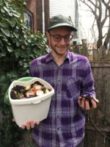Original source: http://hawaiitribune-herald.com/news/local-news/communities-fight-planned-compost-operation-hilo-landfill
Native Hawaiian communities in Keaukaha and Panaewa are gearing up to fight a planned composting facility adjacent to the Hilo landfill, a move that could jeopardize a key component of the county’s plan to close the landfill and recycle more of its waste.
Residents, including Hilo Councilwoman-elect Sue Lee Loy, are asking for a more in-depth study than the environmental assessment currently underway. They’re seeking the more intensive environmental impact statement, or failing that, a study that takes into account all of the government facilities currently impacting the community.
Bobby Yamada, treasurer of the Keaukaha-Panaewa Farmers Association, said the community opposes the plan.
“Our position is no, because the community’s concerns have not been met,” Yamada said Monday.
And some say they’ll take the issue to court, if need be.
The county’s current plan is to have construction begin in April for the $10.5 million composting facility, with it going into operation in 2018, converting green and food waste from all of the island. Non-recyclable garbage from the entire island will be sent to the West Hawaii landfill in Puuanahulu.
Under the plan, transfer stations around the island will continue to serve as drop-off points for household waste, HI-5 recyclables and green waste.
The Hilo landfill has an estimated three years of space left for garbage.
A draft environmental assessment released in August estimates 28,000 tons of organic waste will be composted the first year, ramping up to 35,000 tons by year 10. That includes 18,000 tons from West Hawaii that will be trucked to Hilo.
The county reopened the comment period and extended it to Dec. 12 following an outcry from the residents, several of whom said the county didn’t contact them for input.
Yamada said the community will continue its protests if the finding of no significant impact in the draft EA becomes final, and if their protests aren’t heard, some residents might appeal in court.
“Everybody has that option,” Yamada said. “We’ll just let the process move forward.”
Environmental Management Director Bobby Jean Leithead Todd defended the county’s decision to locate the facility, including a tipping floor and covered windrows to compost the waste, at an old quarry adjacent to the landfill.
Leithead Todd said the facility should create no more noise or odors than the current operations at the landfill. She said the site is the logical choice because most of the infrastructure is already in place. The facility can’t be located at the West Hawaii landfill because of the need for water, she said.
In addition, the operation will offer free mulch that has been processed to kill invasive species such as coqui frogs, ohia fungus, little fire ants and coffee berry borers, as well as local compost at competitive prices, something the farmers could benefit from.
“I understand the concerns, but the operations will be virtually the same,” Leithead Todd said. “In fact, it’s going to be no more and probably less of an impact than the current operations there.”
Leithead Todd said she’s confident the finding of no significant impact will be finalized, and the residents, once they see the benefits, will have their concerns alleviated.
But Lee Loy, whose own Panaewa farm lot is just six houses away from the current landfill, said the new facility is just one more thing added to a community that already has the landfill, airport, Mass Transit baseyard, sewer treatment plant, racetrack and shooting range.
“At the end of this process, our big ask is to cap. No more. To stop taking the easy way,” Lee Loy said during a Nov. 18 community meeting in Keaukaha recorded by Big Island Video News. “It gives the county an opportunity to say this community has done enough, and we need to look somewhere else, somewhere far away. And have other communities help heal our community but also help carry the burden that the Hawaiian Homes community has carried for far too long.”
Lee Loy’s comments were more tempered when contacted Monday. Still, she said, the community has concerns, and it’s her job to represent them. As a planning consultant and freelance legal researcher, as well as a resident, she feels best qualified to communicate the concerns and help reach agreement.
“This just bubbled up from the community, so I just facilitated it,” Lee Loy said. “I’ve been asked to help. Kudos to the community. They really are engaging in the processes that are available to them.”
Public comments can be submitted to Greg Goodale, Solid Waste Division chief, Hawaii County Department of Environmental Management, 345 Kekuanaoa St., Hilo HI 96720 or via email at Gregory.Goodale@hawaiicounty.gov, or to planning consultant PBR Hawaii and Associates Inc., attention Vincent Shigekuni, 1001 Bishop St., Suite 650, Honolulu HI 96813 or via email at vshigekuni@pbrhawaii.com.
The 337-page environmental assessment can be found online at http://oeqc.doh.hawaii.gov/Shared%20Documents/EA_and_EIS_Online_Library/….
Email Nancy Cook Lauer at ncook-lauer@westhawaiitoday.com.
//////////////////////////////////////////////////////////////////////////////////////////////
Asking for a more in-depth EIS is understandable.
Enclosed composting systems are the way to go- open air windrows seem OK, until they’re mismanaged and odors become a problem.
Crunching the numbers, by the time it’s in full operation they’re looking at just under 100 tons per day. Done right, this should be a manageable amount. Done wrong, the community will let you know quickly that it’s a problem.
The statement mentioned accepting bioplastics- that worries me. Which bioplastics are accepted? That’s a well-documented challenge for composting facilities.
With only three years left of landfilling waste, the residents should be happy it’s a composting facility being proposed instead of an incinerator. I wish we could get a proper composting facility here in Philadelphia…
